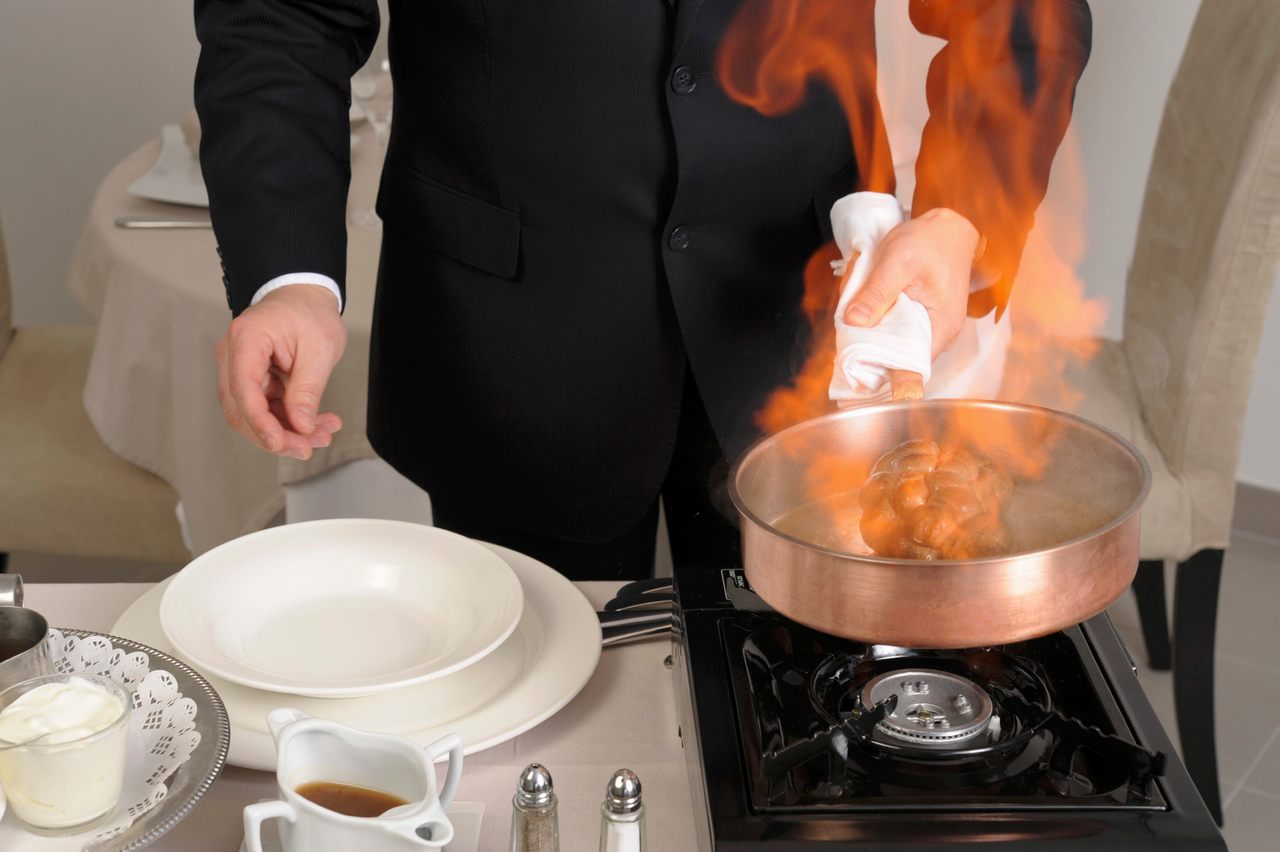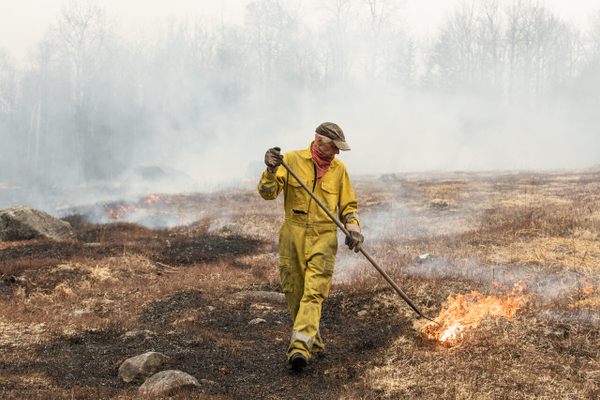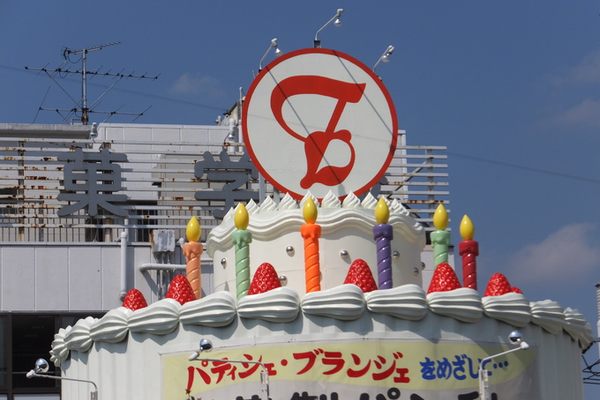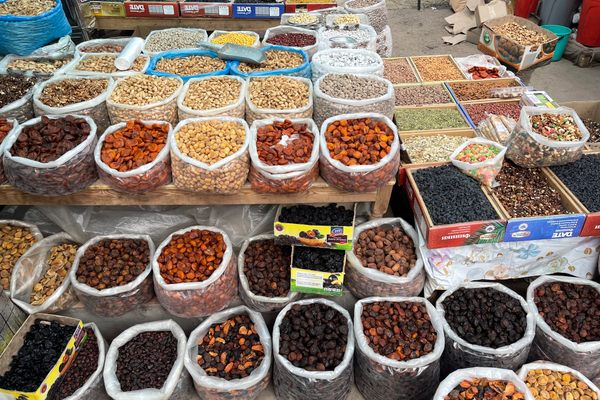Flambé Your Breakfast, Lunch, and Dinner
This retro cooking trend is back.
THIS ARTICLE IS ADAPTED FROM THE MARCH 2, 2024, EDITION OF GASTRO OBSCURA’S FAVORITE THINGS NEWSLETTER. YOU CAN SIGN UP HERE.
Here at Gastro Obscura, we really like playing with fire.
There was the time that editor Sam O’Brien made feuerzangenbowle, a flaming German rum punch with roots in the rowdy student culture of the 1700s. Then there was the night I risked my fingers and eyebrows with the Victorian party game known as Snapdragon, where players compete to pull raisins and almonds out of a puddle of burning brandy.
Both of those were Christmastime traditions, though. I’d argue that adding flaming alcohol to food and drink should be a year-round thing. To find some good recipes, I’ve been paging through a lot of vintage cookbooks containing instructions for the most flamboyant cooking technique: flambé.
Setting food on fire with warm booze was considered the height of luxury for a good chunk of the 20th century. High-end restaurants and cruise ships doused dishes like roast duckling, steak Diane, baked Alaska, and cherries Jubilee with blue-and-gold flames in front of diners, to spectacular effect. In one 1964 book, marketed as “a restaurateur’s guide” to flambé and other table-side services, the author noted that the practice was also “a reliable means of attracting the attention of other tables … and has the effect of provoking repeat orders.”
Besides looking pretty, what does flambéing do to a dish? There’s the taste of the liquor—which could be rum, bourbon, Calvados, or brandy—with some of the potency burned away, resulting in a smoother taste. It’s hotly (ha) debated exactly how much alcohol is removed by the flames, but flambéing does change the flavor of a dish, not only by burning away booze, but by caramelizing sugars and heating the surface of the food to a high temperature.
I’ve flambéed a few things in my time, so I decided to set myself a challenge: to flambé my breakfast, lunch, and dinner over the course of one day.
Breakfast: Crêpes Suzette

Forgive me, purists. I know crêpes Suzette are a dessert, not breakfast. But they are pancakes!
For the recipe, I used my beat-up copy of 1969’s Great Dinners From LIFE, a compilation of elaborate menus, recipes, and groovy photography published in LIFE magazine throughout the 1960s. The picture they used for crêpes Suzette looks like a still from a Connery-era James Bond movie intro sequence.
I made a plate of thin crêpes, then whipped up a sauce of butter, sugar, orange juice, and orange liqueur in a chafing dish. After nestling the pancakes in the sauce, I added a few tablespoons of warmed Cognac and set a match to the plate. Success! I had leaping golden flames, and when they went out, the pancakes were delicious.
Crêpes Suzette has a contested backstory. It may have been invented in Monte Carlo for the Prince of Wales in the 1890s or it could have originated at a restaurant in Paris. Either way, the poster child of flambé cooking is both simple to make and spectacular to eat.

Drink: Coffee Diabolus
Oh man. This one was hard. The recipe came from the Esquire Party Book, published in 1965. I took a long slice of orange peel, studded with cloves, and held it above a pan containing lightly caramelized sugar, a cinnamon stick, and a few tablespoons of rum. Then, theoretically, I was supposed to pour warm brandy down the length of the orange peel, light it, then drop it into the pan. I’d add hot, strong coffee and, voilà!, I’d have coffee Diabolus.
Table-side flambé is meant to show off a waiter’s deftness and training, both of which I lacked while trying to light an orange peel on fire. In the end, I grumpily dropped the peel into the pan, set it on fire there, and then added the coffee. The result was delicious nonetheless: spicy, citrusy, and smooth.
Diabolical coffee like this is an institution at some venerable American restaurants. At Antoine’s and Arnaud’s in New Orleans, they serve what they call café Brûlot table-side, with a technique like the above.
Lunch: Chicken Brochettes Flambé
After such a labor-intensive breakfast, I wanted to make something simpler for lunch. In 1974’s Fondue, Flambé, and Side Table Cooking, I found a recipe for Chicken Brochettes Flambé—in other words, skewers.
I laced chicken, mushrooms, and bits of bell pepper onto a skewer, brushed on a basting sauce, then cooked the skewer on my stovetop. Then, placing the hot skewer on a heat-safe dish, I carefully poured a small amount of flaming brandy over the top. Honestly, flaming this dish didn’t do all that much for the flavor, but it did create a cool effect.
Another 1970s cookbook gave me a good tip on how to easily heat up liquor for flaming. Instead of using a pan on the stove, warming small amounts of booze in the microwave for 15 to 20 seconds did the trick. From there, it was easy to use a match to light the fumes, then pour the flaming liquid over whatever dish I was making.

Dinner: Cornish Game Hens With Blazing Wine Sauce
By dinnertime, my whole apartment smelled like burnt brandy and matches. But I had one last meal to make, and it was a doozy. In 1969’s The Second Chafing Dish Cookbook, I found a recipe for Cornish game hens doused in a sauce made of jelly, spices, and port wine, all set alight with brandy.
After roasting the hens in the oven, I added them to the sauce in a chafing dish, and flambéed the whole thing. The flame caramelized the sweet sauce, and the brandy flavor complemented the other ingredients. Instead of merely a fanciful flourish, flambéing this dish actually increased its deliciousness.

The Future of Flambé
Reading a copy of Gourmet magazine from 1967, I was stunned at how many restaurants featured flambé on their menus, for both ducklings and desserts. But flambé’s flames slowly died down, outside of a few old-school restaurants and cruise-ship dining rooms. As Jane Levi writes in The Oxford Companion to Sugar and Sweets, even the glorious crêpes Suzette is “now somehow redolent of 1970s restaurants, mustachioed waiters, and polished copper pans.”
But these days, restaurant-goers are hungry for a spectacle to match the cost of going out. And flambé is the perfect combination of dinner and a show. Last year, Eater published “Confessions of a Tableside Flambéur,” about the return of flaming dining-room spectacles and the terror of dousing food with fire in front of an audience paying for perfection and social-media pictures.
For those without reservations for fancy restaurants, though, flambé is easy enough at home (maybe avoid making coffee Diabolus for the first time in front of an audience, though). Last year, The New York Times published a how-to-flambé guide with instructions on making the greatest hits: cherries Jubilee, steak Diane, and more.
Gastro Obscura covers the world’s most wondrous food and drink.
Sign up for our email, delivered twice a week.


























Follow us on Twitter to get the latest on the world's hidden wonders.
Like us on Facebook to get the latest on the world's hidden wonders.
Follow us on Twitter Like us on Facebook